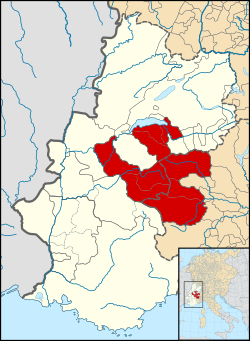County of Savoy
| County of Savoy | ||||||||||
|
||||||||||
|
State of the Holy Roman Empire (from 1032 or 1313)a |
||||||||||
|
||||||||||
|
The County of Savoy and its possessions ( red) within the Holy Roman Empire around the middle of the 13th century. The cream area highlights the rest of the Kingdom of Arles/Burgundy. Note that some of Savoy's possessions lie outside of that kingdom (instead being part of the Kingdom of Italy). Savoy proper is the westernmost of the territories. The unmarked territory directly to the north-west of Savoy proper, Bresse, was acquired in 1272.
|
||||||||||
| Capital | Chambéry (from 1295) | |||||||||
| Government | Principality | |||||||||
| Count of Savoy | ||||||||||
| • | 1003–1048 | Humbert I White Hands | ||||||||
| • | 1391–1416 | Amadeus VIII (Anti-Pope Felix V) | ||||||||
| Historical era | High Middle Ages | |||||||||
| • | Created by Rudolph III, King of Burgundy |
1003 | ||||||||
| • | Inherited March of Turin | 1046 | ||||||||
| • | Emp. Henry VII acknowledged Imperial immediacy | 1331 | ||||||||
| • | Acquired County of Nice | 1388 | ||||||||
| • | Acquired County of Geneva | 1401 | ||||||||
| • | Raised to duchy by Sigismund | 1416 | ||||||||
|
||||||||||
| a. | The Kingdom of Arles, to which the county owed suzerainty became a part of the Empire on King Rudolph III's death in 1032; the County of Savoy gained Imperial immediacy from Emperor Henry VII in 1331. | |||||||||
The County of Savoy (French: Comté de Savoie, Italian: Contea di Savoia) was a State of the Holy Roman Empire which emerged, along with the free communes of Switzerland, from the collapse of the Burgundian Kingdom of Arles in the 11th century.
Sapaudia, stretching south of Lake Geneva from the Rhône River to the Western Alps, had been part of Upper Burgundy ruled by the Bosonid duke Hucbert from the mid 9th century. Together with the neighboring Free County of Burgundy (Franche Comté) it became part of the larger Kingdom of Arles under King Rudolph II in 933.
Humbert the White-Handed was raised to count by the last King of Arles, Rudolph III, in 1003. He backed the inheritance claims of the emperor Henry II and in turn was permitted to usurp the county of Aosta from its bishops at the death of Anselm. Following his support of Conrad II in annexing Arles upon Rudolph's death and suppressing the revolts of Count Odo and Bishop Burchard, he also received the county of Maurienne (formerly held by the archbishops of Vienne) and territories in Chablais and Tarentaise, formerly held by its archbishops at Moûtiers.
...
Wikipedia


